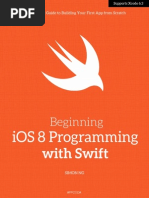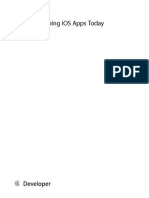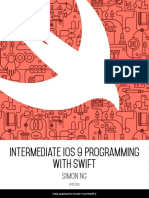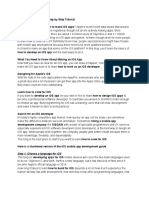Guide to Swift and IOS Development
Uploaded by
Kushagra MishraGuide to Swift and IOS Development
Uploaded by
Kushagra MishraBeginner’s Guide to Swift and iOS Development
Introduction
Swift is a powerful and user-friendly programming language developed by Apple for building iOS
applications. Whether you're new to programming or transitioning from another language, this
guide will help you understand the basics of Swift and how to build your first iOS app.
Getting Started with Swift
Swift is known for its simplicity, safety, and performance. To begin coding in Swift, you need to
install Xcode, Apple’s official development environment.
1. Installing Xcode
● Download Xcode from the Mac App Store.
● Open Xcode and create a new Swift playground to experiment with code.
2. Basic Swift Syntax
Here are some fundamental concepts of Swift:
Variables and Constants
var greeting = "Hello, world!" // Mutable variable
let pi = 3.1416 // Constant value
Data Types
Swift has various data types such as:
let name: String = "John Doe"
let age: Int = 25
let isSwiftFun: Bool = true
Functions
func sayHello(name: String) -> String {
return "Hello, \(name)!"
}
print(sayHello(name: "Alice"))
Building an iOS App
1. Creating a New Xcode Project
● Open Xcode and select "Create a new Xcode project."
● Choose "App" under iOS and select Swift as the language.
2. Understanding Interface Builder
● Storyboard: A visual representation of your app’s UI.
● View Controllers: Manage app screens and user interactions.
● Auto Layout: Helps design responsive layouts.
3. Adding UI Elements
To add a button:
1. Drag a UIButton from the Object Library to the storyboard.
2. Create an IBAction function in your ViewController.swift file:
@IBAction func buttonTapped(_ sender: UIButton) {
print("Button was tapped!")
}
4. Running the App
● Select a simulator and click the "Run" button in Xcode.
● Interact with your app and check for issues in the console.
Conclusion
Swift is a beginner-friendly language that enables the development of powerful iOS applications.
By mastering the basics and exploring Xcode, you’ll be well on your way to building your own
apps. Keep experimenting, learning, and refining your skills!
You might also like
- Swift For Complete Beginners 2022-05-29 (Just The PDF100% (2)Swift For Complete Beginners 2022-05-29 (Just The PDF232 pages
- iOS Developer: Nanodegree Program SyllabusNo ratings yetiOS Developer: Nanodegree Program Syllabus18 pages
- [BookRAR.net] - Programming IOS 14 Using Swift UINo ratings yet[BookRAR.net] - Programming IOS 14 Using Swift UI141 pages
- Beginner's Guide To IOS 12 App Development Using Swift 5 - Xcode, Swift and App Design Fundamentals - NodrmNo ratings yetBeginner's Guide To IOS 12 App Development Using Swift 5 - Xcode, Swift and App Design Fundamentals - Nodrm214 pages
- Preparing For A Technical IOS Job InterviewNo ratings yetPreparing For A Technical IOS Job Interview120 pages
- Basics of iOS Application Development - Beginning DevOps On AWS For iOS Development - Xcode, Jenkins, and Fastlane Integration On The CloudNo ratings yetBasics of iOS Application Development - Beginning DevOps On AWS For iOS Development - Xcode, Jenkins, and Fastlane Integration On The Cloud10 pages
- Beginner's Guide To IOS 11 App Development Using Swift 4100% (1)Beginner's Guide To IOS 11 App Development Using Swift 4215 pages
- Programming iOS With Swift 5.3 For Beginners To Pro in 1 Hour (2021 Edition) - A Crash Course On Developing iOS and Mac Apps Using Swift 5.3 and Xcode 12.3No ratings yetProgramming iOS With Swift 5.3 For Beginners To Pro in 1 Hour (2021 Edition) - A Crash Course On Developing iOS and Mac Apps Using Swift 5.3 and Xcode 12.3157 pages
- Complete Download Transitioning To Swift Scott Gardner PDF All Chapters100% (1)Complete Download Transitioning To Swift Scott Gardner PDF All Chapters79 pages
- Instant Download (Ebook) Head First Swift by Gray, Anthony, Manning, Jon, Buttfield-Addison, Paris ISBN 9781491922859, 1491922850 PDF All Chapters100% (1)Instant Download (Ebook) Head First Swift by Gray, Anthony, Manning, Jon, Buttfield-Addison, Paris ISBN 9781491922859, 1491922850 PDF All Chapters65 pages
- Beginning iOS Programming with Swift and SwiftUI (iOS 18 and Xcode 16) (Simon Ng) (Z-Library)No ratings yetBeginning iOS Programming with Swift and SwiftUI (iOS 18 and Xcode 16) (Simon Ng) (Z-Library)675 pages
- Reading Assignment I: Intro To Swift: ObjectiveNo ratings yetReading Assignment I: Intro To Swift: Objective10 pages
- Building An iOS App - A Step-by-Step Tutorial0% (1)Building An iOS App - A Step-by-Step Tutorial3 pages
- Swift Programming: Fathima Sherin Sherief VTH Sem, MCANo ratings yetSwift Programming: Fathima Sherin Sherief VTH Sem, MCA56 pages
- R1UC514T iOS App Design and Development SyllabusNo ratings yetR1UC514T iOS App Design and Development Syllabus1 page
- IOS Programming For Beginners: The Simple Guide to Learning IOS Programming Fast!From EverandIOS Programming For Beginners: The Simple Guide to Learning IOS Programming Fast!No ratings yet
- Introduction to IOS Mobile Application DevelopmentNo ratings yetIntroduction to IOS Mobile Application Development9 pages
- Full Download Swift Recipes for iOS Developers: Real-Life Code From App Store Apps 1st Edition Alexander Nekrasov PDF DOCX100% (1)Full Download Swift Recipes for iOS Developers: Real-Life Code From App Store Apps 1st Edition Alexander Nekrasov PDF DOCX65 pages
- Unit - 8 Introduction To IOS ProgrammingNo ratings yetUnit - 8 Introduction To IOS Programming37 pages
- iOS 5 Programming Cookbook Solutions Examples for iPhone iPad and iPod touch Apps 1st Edition Vandad Nahavandipoor instant downloadNo ratings yetiOS 5 Programming Cookbook Solutions Examples for iPhone iPad and iPod touch Apps 1st Edition Vandad Nahavandipoor instant download62 pages
- (Mastering Computer Science) Sufyan Bin Uzayr - Mastering Swift - A Beginner - S Guide-CRC Press (2022)100% (1)(Mastering Computer Science) Sufyan Bin Uzayr - Mastering Swift - A Beginner - S Guide-CRC Press (2022)351 pages
- iOS 17 App Development for Beginners: Get started with iOS app development using Swift 5.9, SwiftUI, and Xcode 15 (English Edition)From EverandiOS 17 App Development for Beginners: Get started with iOS app development using Swift 5.9, SwiftUI, and Xcode 15 (English Edition)No ratings yet
- Coding Basics with Microsoft Visual Studio: A Step-by-Step Guide to Microsoft Cloud ServicesFrom EverandCoding Basics with Microsoft Visual Studio: A Step-by-Step Guide to Microsoft Cloud ServicesNo ratings yet
- iOS Programming: Starter Guide: What Every Programmer Needs to Know About iOS ProgrammingFrom EverandiOS Programming: Starter Guide: What Every Programmer Needs to Know About iOS Programming2/5 (1)
- Starting an Online Business_ A Step-by-Step GuideNo ratings yetStarting an Online Business_ A Step-by-Step Guide1 page
- The Future of AI_ Trends, Ethics, and InnovationsNo ratings yetThe Future of AI_ Trends, Ethics, and Innovations2 pages
- The Art of Focus_ A Guide to Deep Work and ProductivityNo ratings yetThe Art of Focus_ A Guide to Deep Work and Productivity2 pages































































